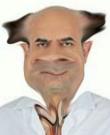


















OSTEOPOROSIS
By Dra. Annabel Carungin
دکتر رحمت سخنی از مرکز آموزشی درمانی امام خمینی (ره) ارومیه
Bone forms the skeleton, whick provides the mechanical framework for the body, is the body"s major store of calcium and protects the internal organs. The skeleton should withstand mechanical stress and must be available for provision of calcium to maintain homeostasis.
Osteoporosis is a progressive disease in which the bones gradually become weaker and weaker, causing changes in posture and making the individual extremely susceptible to bone fractures. The term osteoporosis, derived from Latin, literally means "porous bones". Because of the physiological, nutritional and hormonal differences between males and females, osteoporosis primarily affects women. In the United States, it is the most prevalent metabolic bone disease. Indeed, this debilitating disease afflicts more women than heart disease, stroke, diabetes, breast cancer or arthritis. Fully half of all women between the ages of forty five and seventy five show signs of some degree of osteoporosis. Over a third of that group suffer from serious bone deterioration. In the future, metabolic and age-related bone loss sysndromes will create an increasingly significant health care problem.
Bone mass - The amount of mineral in the bone, generally reaches its peak when a woman is between the ages of thirty and thirty five. After that, it then begins to decline. Between the ages of fifty five and seventy, women typically experience a 30-40% bone loss.
The adult skeleton undergoes a continual process of remodeling in which bone resorption is coupled with bone formation. The entire remodelling cycle, from activation to complete repair, takes about 100 days. At any onetime, about 2 million remodelling units are active throughout the human skeleton. Bone resorption and formation are coupled. In ideal homeostatis, the amount of bone at the initiation of a remodelling cycle is expected to be equal to the amount of bone at the completion of the same cycle. Whenever bone resorption exceed bone formation, osteopenia or osteoporosis occurs.
Unfortunately, bone loss causes no symptoms while it is occuring, so it goes unnoticed until significant loss has occurred. It is very common for a woman to be completely unaware of having osteoporosis until what should have been a minor accidents causes her to break a bone, often a wrist or hip. If osteoporosis becomes quite advanced, even an enthusiastic hug can result in cracked or broken ribs. As bone loss advances, the vertebrae are subject to what called compression fractures, crowding the nerves of the spine and various internal organs and causing a lost of height. This can be very painful. It is this compression that causes the "dowager"s hump" that many women develop as they age. Osteoporosis can also be a contributing factor in toothloss; when the structure of the jawbone weakens, it can no longer hold the teeth firmly in place.
Many people have the impression that osteoporosis is caused solely by a dietary calcium deficiency and that it therefore can be remedied by taking calcium supplement. This is not quite correct. While calcium supplementation is important in dealing with osteoporosis, there are other condsiderations as well.
Several hormonal agents can affect the function of the bone cells. The know regulators of calcium homeostasis in humans are parathyroid hormone, 1,25 - dihydroxyvitamin D3 and possibly calcitonin. The imbalance of these hormones can contribute to bone loss. Changes in hormone levels can be associated with an increased risk of osteoporosis. Among these are changes in the serum parathyroid hormone concentration with age. Decreased renal function decreases the plasma 1,25 dihydroxyvitamin D3 level, and this effect may stinmulate the secretion of parathyroid hormone indirectly or directly.
Vitamin C,D,E and K all play vital roles in battling osteoporosis, as does protein. Regulating the amounts of certain minerals such as magnesiun, phosphorus, silicon, boron, zinc,manganese and copper in the body are also important in maintaining proper calcium levels. Exercise is another vital factor.
There are 2 basic types of osteoporosis. Type I was known to be caused by hormonal changes, particularly a loss of estrogen, which causes the loss of minerals from the bones to accelerate. Type II is linked to dietary deficiency, especially a lack of sufficient calcium and vitamin D, which is necessary for the absorption of calcium. Many women mistakenly believe that osteoporosis is something they need be concerned about only after menopause. However, recent evidence indicates that osteoporosis often begins early in life and is not strictly a postmenopausal problem. Although bone loss accelerates after menopause, as a result of the drop in estrogen leveles, it begins in the premenopausal years.
A number of factors are known to influence an individual"s risk of developing osteoporosis. The first and probably the most important is the peak bone mass achieved in adulthood; the larger and denser the bones are to begin with, the less debilitating bone loss is likely to be. Small, fine-boned women therefore have more reason for concern than women with larger frames and heavier bones. Dietary and lifestyle habits are important as well. Insufficient calcium intake is one factor, but equally important are other dietary practices that affect calcium metabolism. A diet high in animal protein, salt and sugar causes the body to excrete increased amounts of calcium. The body then is forced to "steal" calcium from the bones to meet its requirements. Caffeine, alcohol and many other drugs have a similar effect. To much magnesium and / or phosphorus (found in most sodas and many processed food products) can inhibit the body from absorbing calcium properly, because these minerals compete with calcium for absorption in the blood and bone marrow. Bone density also depends on exercise. When it gets regular weight-bearing exercise (such as walking), the body responds by depositing more minerals in the bones, especially the bones of the legs, hips and spine. Conversely, a lack of regular exercise accelerates the loss of bone mass.
Other factors that make one more likely to develop osteoporosis include smoking, late puberty, early menopause (natural or artificially induced), a family history of the disease, hyperthyroidism, chronic liver or kidney disease and long term use of corticosteroids, anti-seizure medications or anticoagulants.
While osteoporosis causes no specific symptoms until it is advanced, there are some early warning signs that may signal bone loss is occuring. These include a gradual loss of height, a stooping or rounding of the shoulders and generalized aches and pains. If you notice that your clothes seem to be getting longer, that may be a clue.
Recommendations:
1. Eat plenty of foods that are high in calcium and vitamin D. Good sources of easily assimilable calcium include broccoli, clams, most dark green leafy vegetables, hazelnuts, molasses, oats, oysters, salmon, sardines (with the bones), sea vegetables, sesame seeds, shrimps, soybeans, tofu and wheat germs.
2. Consume whole grains and calcium foods at different times. Whole grains contain a substance that binds with calcium and prevents its uptake. Take calcium at bedtime, when it is best absorbed and also aids in sleeping.
3. Include garlic and onions in the diet, as well as eggs (if your cholesterol level is not too high). Thses foods contain sulfur, which is needed for healthy bones.
4. Limit your intake of almonds, asparagus, cashews and spinach. These foods are high in oxalic acid, which inhibits calcium absorption.
5. Avoid phosphate-containing drinks and foods such as soft drinks, high- protein animal foods and alcohol. Avoid smoking, sugar and salt. Limit your consumption of citrus fruits and tomatoes; these oods may inhibit calcium intake.
6. Avoid yeast products. Yeast is high in phosphorus, which competes with calcium for absorption by the body.
7. If you are over 55 years old, include a calcium lactate (if you are not allergic to milk) or calcium phosphate supplement in your daily regimen, and take hydrochloric acid (HCl) supplements. In order for calcium to be absorbed, there must be an adequate supply of Vitamin D as well as sufficient HCl in the stomach. Older people often lack sufficient stomach acid.
8. If you"re taking thyroid hormone or an anticoagulant drug, increase the amount of calcium you take by 25 to 50%..
9. If you"re taking a diuretic, consult your physician before beginning calcium and vitamin D supplementation. Thiazide type diuretics increase blood calcium levels and complications may result if these drugs are taken in conjunction with calcium and vitamin D supplements. Other types of diuretics increase calcium requirements, however.
10. Keep active, and exercise regularly. A lack of exercise can result in the loss of calcium, but this can be reversed with sensible exercise. Walking is probably the best exercise for maintaining bone mass.
11. Do Biomagnetic Therapy.
a. Meridian Energizing treatment, 3 times a day for 7 days to 2 weeks.
b. Daytime sternum and Nighttime treatment (daily).
c. Drink Magnetized Negative water with MSO.
http://www.sahand272.blogfa.com/
http://www.rs272.parsiblog.com/
WEST AZERBAIJAN URMIA--Dr.RAHMAT SOKHAN